Working with the logframe, planning and budget
When you design a project, the starting point is the Logical Framework window. Once you have identified your project's logic, how the working environment may influence your project (risks, assumptions, dependencies) and how you will keep track of your project, you can start detailing your planning and budget.
The Logical Framework window, the Planning window and the Budget window have a similar set-up: the main window contains the logframe, planning or budget. If you press <Ctrl><D> (or use the Show Details button in the Lay-out toolbar) you will get the Details pane in the bottom part of the window.
If you want to create an IATI organisation file (by setting the view mode to IATI organisation), you will see an additional Expenses window. This works entirely the same as the Budget window.
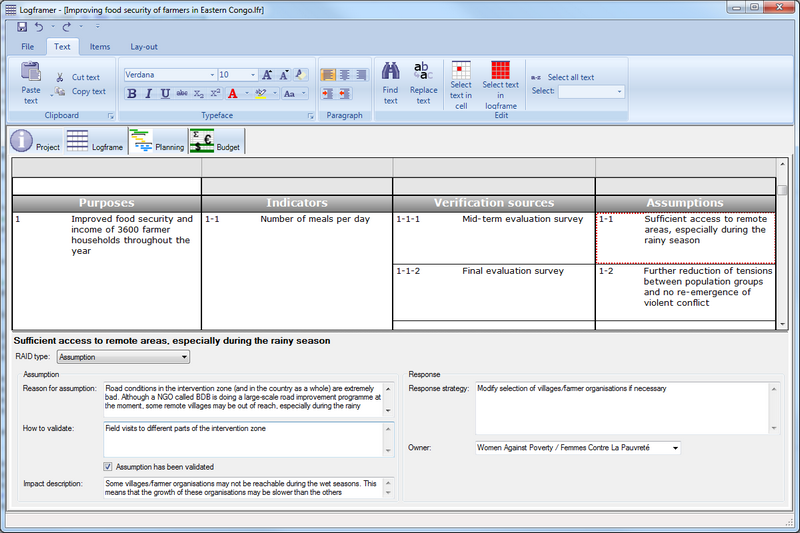
The main window contains the grid of the logframe, planning or budget. In this grid you can:
- Enter text in text fields (all fields of the logframe, second column of the planning and budget) and use the Text toolbar to turn text bold or italic, change the typeface and size, change the text or background colour, etc.
- Move items around: different types of items in Logframer are linked to each other in a specific and hierarchical way. Your project's outcome can have different outputs and each output can have several activities for instance. If you move an output or activity, its child items (indicators, resources, risks...) will move with it - or not if you don't want them to. Don't worry about numbering items, Logframer will do all that for you.
- Copy and paste items: because of the relationships between items, you can copy an item with all its child items - or not if you don't want to.
- Change the lay-out of your logframe/planning/budget: you can make different versions of your logical framework, planning or budget and print them or export them to MS Word or Excel. Use the Lay-out toolbar to change the appearance or to focus on a particular part you're working on.
In this section you will learn how to work with the logframe, planning and budget and how to modify their appearance. For more control over colours and typefaces of titles etc. see the topic about the Logframer settings.
Working with the logframe
To design the logical framework of your project, select the Logframe tab.
The Logical Framework window allows you to design the logframe of course, but using the Details pane you can also add additional information. This in turn will allow you to design specific tools:
|
Main window |
Details pane |
Tools |
|
Goals |
Project information (1) |
|
|
|
List of partners (1) |
List of partner organisations for project documentation |
|
Purposes |
Target groups (1) |
|
|
Outputs |
Key Moments (2) |
|
|
Processes, activities & sub-activities |
Preparation and follow-up periods (2) |
|
|
|
Repeating activities (2) |
|
|
Indicators and sub-indicators |
17 different types of indicators |
Monitoring tool in Excel |
|
|
Targets and scores |
|
|
|
Statements and responses |
Questionnaires / indicator lists |
|
|
Value ranges |
|
|
Verification sources |
|
Included in Performance Measurement Framework |
|
Risks, assumptions and dependencies |
Detailed information according to RAID typology |
|
|
|
|
|
|
Resources |
References to specific budget items and % used for that particular resource |
(1) You can also do this in the Project Information window
(2) You can also do this in the Planning window. In the Details pane of the logframe you can modify dates, durations and so on, but in the Planning window you have drag-and-drop functionality
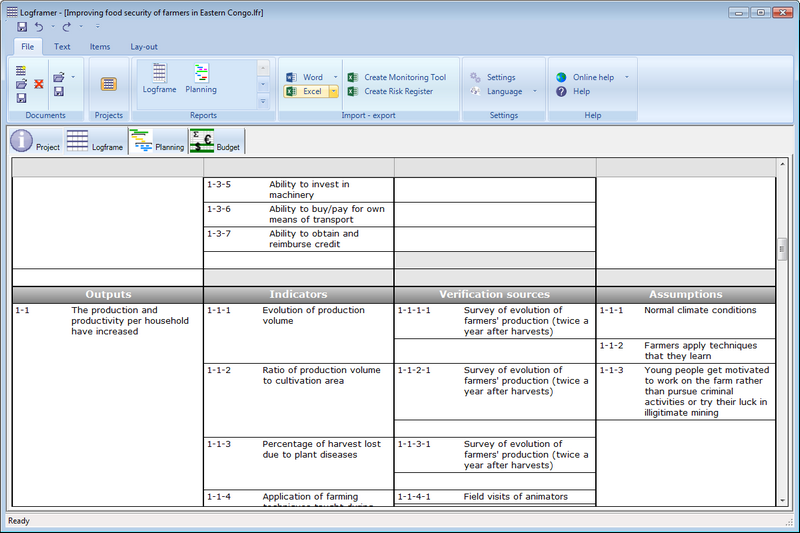
Logframe items
The logical framework allows you to design the structure of your project, containing the following logframe items:
- Project logic items are arranged in the first column, in four sections:
- Goals (top section) or long term objectives: these are the broad objectives on the level of the (local) society that your project contributes to. This means you don't expect them to be achieved entirely by your project, but it will help advance the local society towards these objectives. As such, this means you don't have these objectives fully under your control.
- Purposes: a purpose explains why your project exists in the first place. It is the main objective of your project, which you hope to achieve by its completion (medium-term objective). It is often recommended to have no more than a single purpose in your project, but Logframer can handle more than one purpose. If you do have more than one purpose, your outputs and activities will be grouped per purpose.
- Outputs: these are the direct and tangible results of the activities and processes of the project. For each purpose, you can have as many outputs as you want.
- Activities: to achieve each output, you can include one or more activities designed to create this output. You can even split up larger processes (activities) into sub-activities (or smaller processes split up into sub-sub-activities and so on).
- Indicators are listed in the second column. For each objective (goal, purpose, output) or activity you can identify as many indicators as you want. Indicators can also have sub-indicators (and sub-sub-indicators etc.) You can design indicators to follow up each type of objective:
- Impact indicators to follow the evolution of the goals
- Effect indicators to follow up the progress towards the purpose(s)
- Output indicators to follow up the delivery of outputs
- Process indicators to follow up the progress of activities and processes
- Verification sources are listed in the third column. For each indicator you can include one or more verification sources
- Risks, assumptions and dependencies are listed in the fourth column. For each objective you can list as many risks, assumptions and dependencies as you want
- Resources are only available in the Activities section at the bottom. Here you can switch the view from listing indicators and verification sources for each activity, or the resources and budget. For every (sub-)activity you can list as many resources as you want. In the Budget column of the logframe (bottom of the Verification Sources column) you can specify an indicative total for the resources. Alternatively, you can calculate this amount by selecting items from the budget.
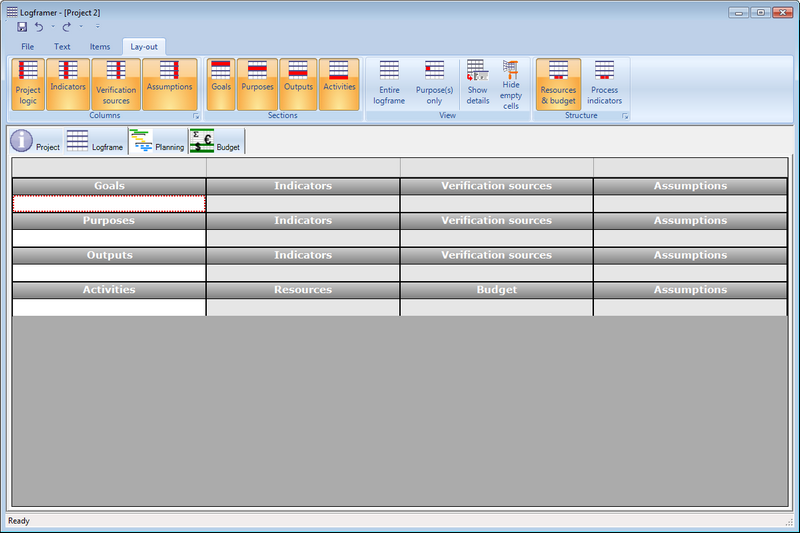
Parent-child relations
Logframe items are linked to each other in two ways:
- Purposes, outputs and activities are vertically linked to each other (vertical logic): each purpose can have several outputs, each output can have several activities and each activity (process) can have several sub-activities (and so on). Each indicator can also have several sub-indicators (and sub-sub-indicators and sub-sub-sub-indicators and so on).
- Objectives or activities can have several indicators and several risks/assumptions/dependencies. Each indicator can have several verification sources. This is the horizontal logic.
When you move items around, Logframer will make sure the vertical and horizontal logic remains intact. This means for instance that when you drag output 2 before output 1, that in the bottom section the activities of output 2 will also be placed before the activities of output 1.
When you move an indicator that has several verification sources and you only select the indicator itself, the verification sources will remain in place and you will see a place-holder text.
Adding items and working with text
To add an item, simply click in an empty box and start to type. At the bottom of each section in each column you will always find an empty text box. If these empty boxes are not visible, select the Lay-out toolbar and click on the Show empty cells button in the View section.
You can edit the text like you would in any word processor using the Text toolbar. You can change the typeface or size, make text bold, underlined, etc. and align the text to the left, right or centre.
If you want to change the appearance of all text in the logframe, or all the text in the Indicators column for instance, use the text selection options to select multiple cells and then modify the text to your liking.
Moving items around
You can move a single item or a group of items from one section to the other or from one column to the other, or simply change the order that the items are displayed.
To select a single item, click on it with the left mouse button. To select more than one item, press the left mouse button and drag. The red selection rectangle will expand to include other cells, but you can only select cells within a single section.
To move items, press the right mouse button within your selection (red selection rectangle) and drag it to the place where you want to insert the items. A green indicator line will appear and show the current location. When you come close to the top or bottom border of the logframe, it will scroll up or down. Release the right mouse button to insert the items you selected.
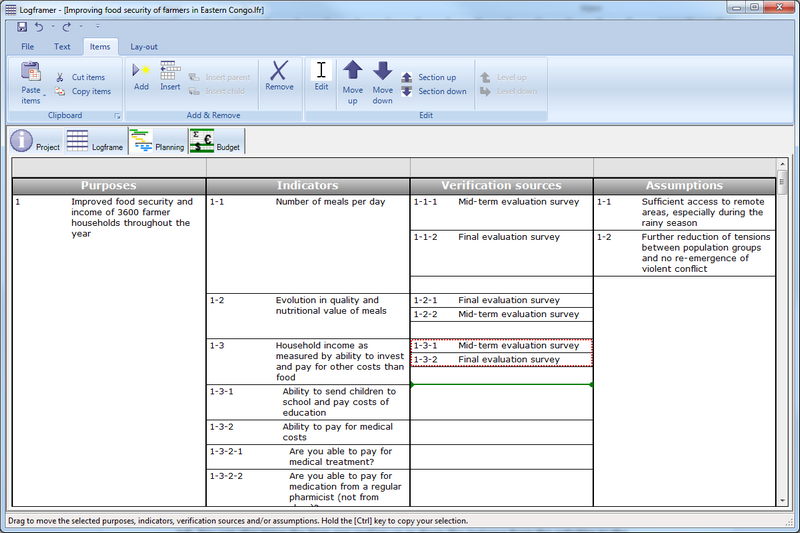
Another way to move items is to use the Move Up and Move Down buttons in the Items toolbar. You can also move the item one section up or down (for instance from the activities to the outputs section).

Copying and pasting items
You can cut, copy and paste items in three different ways. First select the items you want to cut or copy (see ‘Moving items around’).

- Use the Cut, Copy and Paste buttons of the Items ribbon tab.
- Press Ctrl+X to cut; Ctrl+C to copy and Ctrl+V to paste
- Right click into the red selection rectangle and move the green indicator line to where you want to copy the item(s) (see ‘Moving items around’). But this time hold the Ctrl button when you release the right mouse button. This will copy the selected item(s) instead of cutting and pasting them.
Changing the lay-out of the logframe
Using the Lay-out toolbar, you can hide columns and sections; hide everything but your project's main purpose(s); switch between viewing the process indicators or the resources; and show or hide the Details pane.

This enables you to make custom versions of the logframe, which you can then print or export to MS Word or MS Excel. It also allows you to hide the columns or sections that you are not working, making it easier to focus.
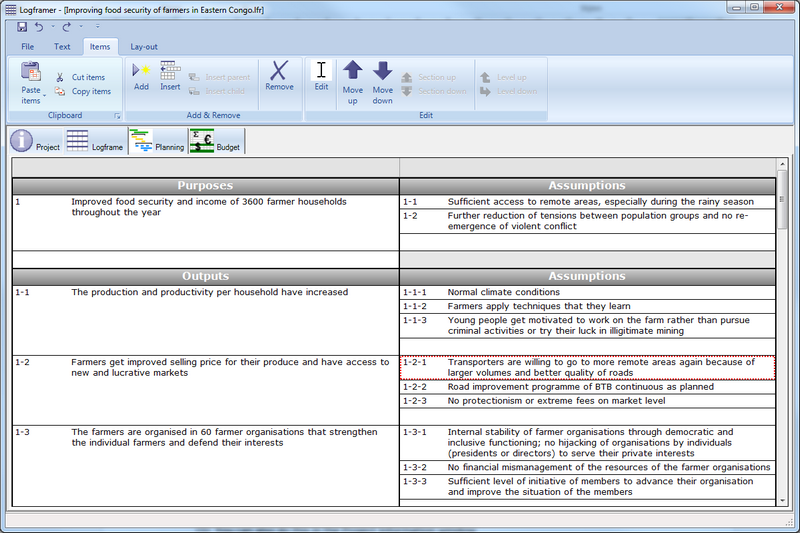
The Lay-out toolbar has the following ribbon panels and buttons:
- Columns ribbon panel: hide or show the Indicators, Verification Sources and/or Assumptions column. The Project Logic column will always remain visible, but if you click this button the three other columns will hide or show.
- Sections ribbon panel: hide or show the Goals section, the Purposes section, the Outputs section and/or the Activities section
- View ribbon panel:
- Show the entire logframe
- Show the project's main purpose(s) only
- Hide or show the Details pane at the bottom of the screen
- Hide empty cells: click this button to hide the empty cells at the bottom of each group of items. This will make the view of the logframe more compact. You can still insert or add items using the Items ribbon.
- Structure ribbon panel: in the Activities section (bottom section of the logframe), you can choose between viewing process indicators and their verification sources (columns 2 and 3), or the resources and (estimated) cost necessary for each activity.
Tools: the logical framework
You can print the logical framework, export it to MS Word or to MS Excel. When you print or export the logframe, you can customise its appearance:
- You can show or hide columns
- You can show or hide sections (goals, purposes, outputs, activities)
- In the activities section, you can choose between showing the performance indicators and their verification sources, or the resources and budget necessary for each activity.
This way you can easily produce different versions of the logframe for your funding applications, for training purposes, for communication purposes, for project management, etc.
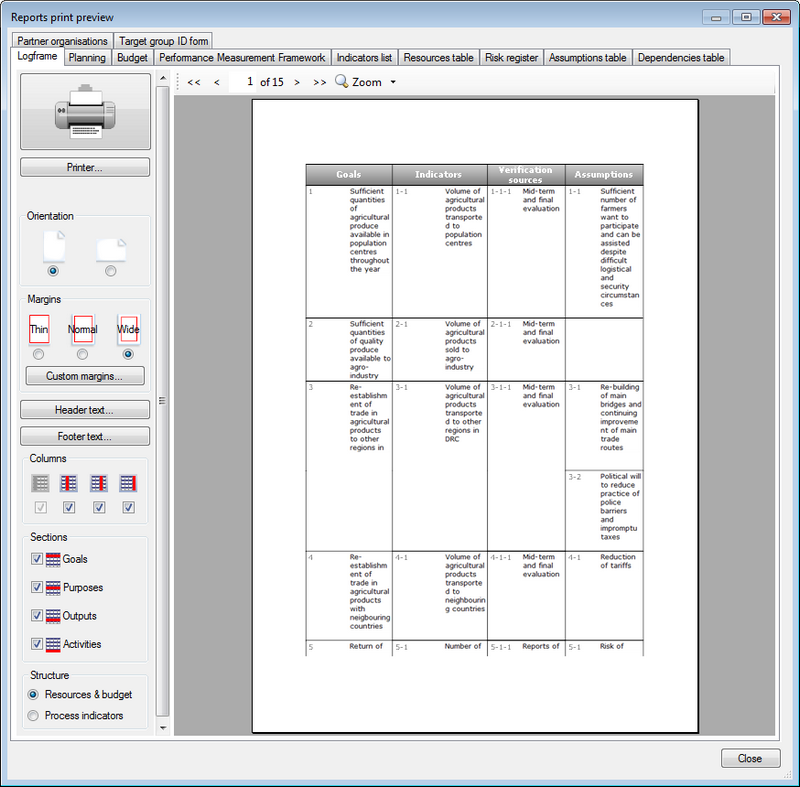
Working with the planning
To design the planning of your project, select the Planning tab.
The Planning window allows you to plan the project's key moments, processes and activities. Using the Details pane you can also specify additional information. This in turn will allow you to design specific tools:
|
Main window |
Details pane |
Tools |
|
Key moments |
Relation of key moment to other key moments or activities (1) |
|
|
Processes |
Who organises and where (1) |
|
|
|
Child activities (1) |
|
|
Activities & sub-activities |
Relation of activity to other key moments or activities (1) |
|
|
|
Duration of activity (1) |
|
|
|
Who organises and where (1) |
|
|
|
Preparation and follow-up periods (1) |
|
|
|
Repeating activities (1) |
|
(1) You can also do this in the Logframe window. In the Details pane of the logframe you can modify dates, durations and so on, but in the Planning window you have drag-and-drop functionality.
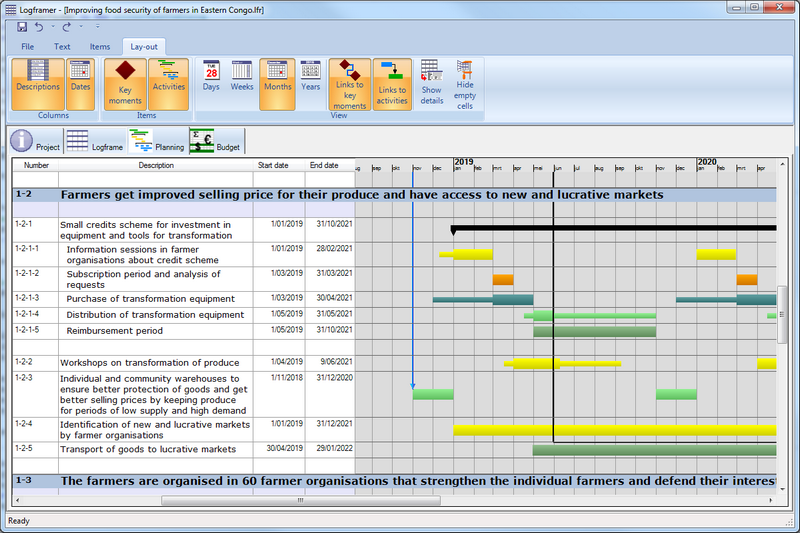
Planning items
The planning window allows you to plan the different activities and key moments (milestones) of your project. It contains the following items:
- Key moments such as deadlines, milestones, external events, etc.
- Processes, which consist of several activities
- Activities, which can exist on their own or as part of a larger process. If you add sub-activities to a parent activity, it becomes a process.
Activities, processes and key moments are grouped per output of your logical framework. Key moments are always ordered by date.
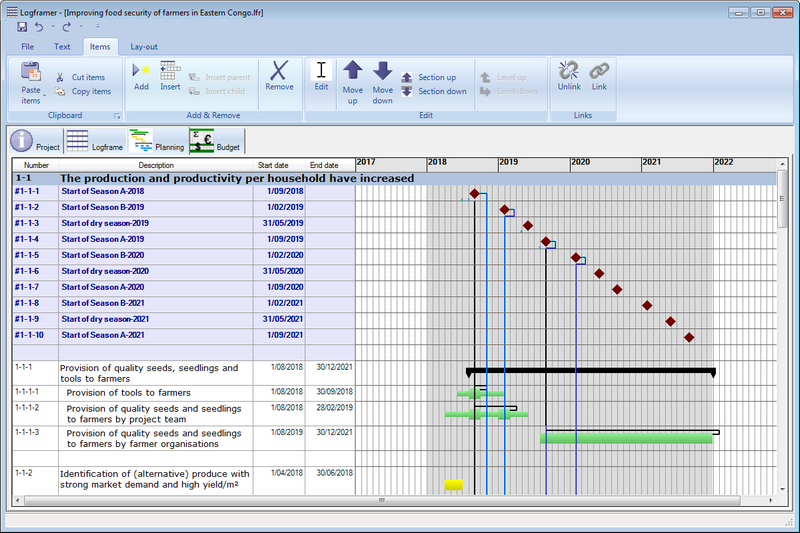
Parent-child relations
Planning items are linked to each other in two ways:
- Outputs and key moments are vertically linked to each other (vertical logic): each output can have several key moments
- Outputs and activities are vertically linked to each other (vertical logic): each output can have several activities
- Each activity (process) can have several sub-activities (and so on)
When you move items around, Logframer will make sure the vertical logic remains intact. This means for instance that when you drag output 2 before output 1, that the key moments and activities of output 2 will also be placed before those of output 1.
Adding items and working with text
For each output, there are two sections in the main planning window. Directly below the output you can enter key moments in the blue section. If this blue section is not visible, go to the Lay-out toolbar and in the Items section click on the Key moments button.
Below the blue key items section in the planning is the activities section (in white). To add an activity, simply start typing in an empty cell. If the white activities section is not visible, go to the Lay-out toolbar and in the Items section click on the Activities button.

You can edit the text of the activities and processes like you would in any word processor using the Text ribbon tab. You can change the typeface or size, make text bold, underlined... and align the text to the left, right or centre.
You can't change the typeface etc. of the key moments.
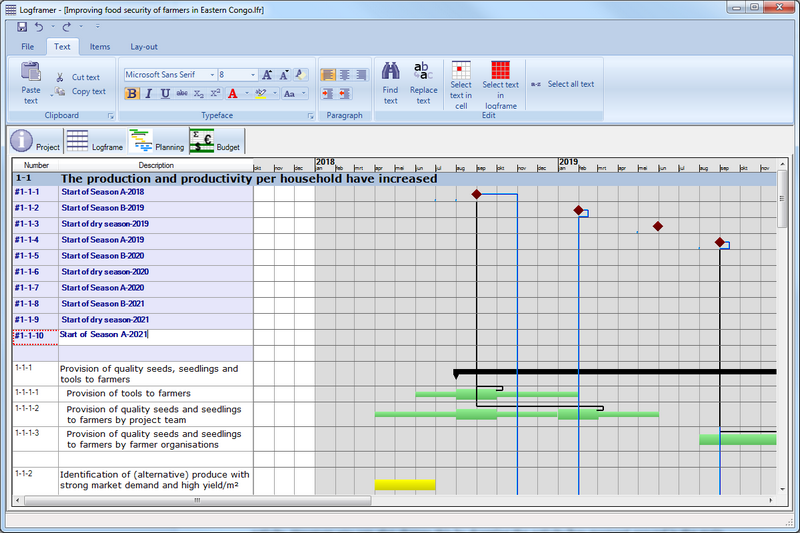
Moving items around
You can move a key moment to another output. But you can't change the order of the key moments of a certain output because they are ordered according to date.
You can change the order of the activities of an output and drag activities from one output to the other.
To select a single item, click on it with the left mouse button. To select more than one item, press the left mouse button and drag. The red selection rectangle will expand to include other cells, but you can only select cells within a single section.
To move items, press the right mouse button within your selection (red selection rectangle) and drag it to the place where you want to insert the items. A green indicator line will appear and show the current location. When you come close to the top or bottom border of the logframe, it will scroll up or down. Release the right mouse button to insert the items you selected.
Another way to move items is to use the Move Up and Move Down buttons in the Lay-out ribbon tab (only enabled for activities, not for key moments). You can also move the item one section up or down (from one output to the other).

Copying and pasting planning items
You can cut, copy and paste items in three different ways. First select the items you want to copy paste (see ‘Moving items around’).
- Use the Cut, Copy and Paste buttons of the Items ribbon tab.
- Press Ctrl+X to cut; Ctrl+C to copy and Ctrl+V to paste
- Right click into the red selection rectangle and move the green indicator line to where you want to copy the item(s) (see ‘Moving items around’). But this time hold the Ctrl button when you release the right mouse button. This will copy the selected item(s) instead of cutting and pasting them.

Dragging to change start, end and duration of activities and key moments
You can use the Details pane to specify the date of a key moment or the start date and duration of an activity. However you can also change this by dragging the activity/key moment around in the main window.
Key moments:
- Click and hold the key moment with the left mouse button. Drag it in the direction of the date you want to place it. You will see a date appearing next to the key moments symbol (the red diamond shape), allowing you to release it exactly on the right date.
- Notice that the key moments are listed according to date. So if your key moment comes before or after other key moments, it will change its place in the list (going up or down in the list).

Activities:
- To change the starting date of the activity: click and hold the left side of the activity bar and then drag it in the direction of the date you want to place it. You will see a date appearing next to the activity bar, allowing you to release it exactly on the right date. This operation will not change the duration of the activity

- To change the end date of the activity: click and hold the right side of the activity bar and then drag it in the direction of the date you want to place it. You will see a date appearing next to the activity bar, allowing you to release it exactly on the right date. This operation will change the duration of the activity.
- To move the activity without changing the duration: click and hold somewhere inside the activity bar and then drag it in the direction of the date you want to place it. You will see two dates appearing next to start and end of the activity bar, allowing you to release it exactly on the right date. This operation will not change the duration of the activity.
- A shorter/longer preparation period: click and hold the left side of the thin preparation bar before the activity and then drag it in the direction of the date you want to place it. You will see a date appearing next to the preparation bar, allowing you to release it exactly on the right date. This operation will change the duration of the preparation period but will not change the start date or duration of the activity.

- A shorter/longer follow-up period: click and hold the right side of the thin follow-up bar on the right side of the activity and then drag it in the direction of the date you want to place it. You will see a date appearing next to the follow-up bar, allowing you to release it exactly on the right date. This operation will change the duration of the follow-up period but will not change the start date or duration of the activity.
Changing the lay-out of the planning
Using the Lay-out toolbar, you can hide certain columns; hide or show key moments and/or activities; select the level of detail of the Gantt chart; hide or show links between key moments and activities; and show or hide the Details pane.

The Lay-out toolbar has the following ribbon panels and buttons:
- Columns ribbon panel: hide or show the Dates column. The Descriptions column will always remain visible.
- Items ribbon panel: hide or show the key moments and/or the activities.
- View ribbon panel:
- Set the level of detail of the Gantt chart to days, weeks, months or years
- Show or hide the links between key moments and/or activities
- Hide or show the Details pane at the bottom of the screen
- Hide empty cells: click this button to hide the empty cells at the bottom of each group of items. This will make the view of the planning more compact. You can still insert or add items using the Items ribbon.
Working with the budget
To design the planning of your project, select the Budget tab.
If you want to create an IATI organisation file (by setting the view mode to IATI organisation), you will see an additional Expenses window. This works entirely the same as the Budget window.
The Budget window allows you to identify budget headers that group individual budget items (or sub-headers). A budget can be set up as a single-page budget or as a multi-year budget. In the Budget window, the Details pane has a limited role. You can use it if you want to create a budget item that represents a percentage (ratio) of another item (or total).
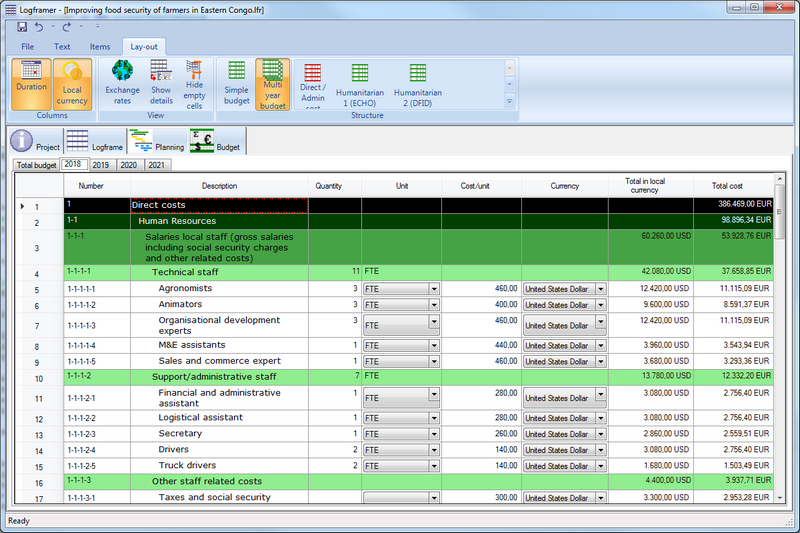
Budget items

A budget has:
- Budget items: a budget item calculates the cost for a specific item. You can enter:
- The description of the item
- Its duration and duration unit: for instance to calculate wages: 12 months
- Its quantity: for instance ‘5 items ‘or ‘3 persons’. You can select an existing unit from the drop-down list or enter a new one.
- Its unit cost:
- Unit cost expressed in the default currency: simply enter the unit cost of the item
- Unit cost expressed in a local currency: enter the number and select a currency from the Currency drop-down list. If the currency you need is not available, use the Exchange rates window to add new local currencies.
- Budget headers: these group a series of budget items. A budget header can also group other budget headers and you can create as many levels as you like. Logframer automatically calculates the totals of the budget header:
- The total duration: a total will only be made if the duration unit of all the items is the same
- The total quantity: a total will only be made if the number unit of all the items is the same
- The total local currency: a total will only be made if the local currency of all the items is the same
- The total cost
You don't have to fill out all the cells for a budget item. You can:
|
Enter |
Total cost is |
|
Cost/unit only |
Cost/unit |
|
Quantity and a cost per unit |
Quantity x Cost per unit |
|
Duration and a cost per unit |
Duration x Cost per unit |
|
Duration, quantity and cost per unit |
Duration x Quantity x Cost per unit |
A special kind of budget item is the Ratio budget item. With a Ratio item, you can specify that one cost equals to a certain percentage (ratio) of another item or budget header. To create a ratio item:
- Make sure the Details pane is visible (if not, go to the Lay-out toolbar and in the View section click on Show Details).
- On the Type tab of the Details pane, set the Type to ratio using the drop-down list
- In the table that appears, select the reference row that will be the source for your item
- Specify the ratio as a percentage of the amount you're referring to

A ratio item is practical if you have for instance administration costs that are a fixed percentage of the total working costs, or if you want to calculate an amount for contingencies as a percentage of other costs.
Moving items around
To select a single budget item, click on it with the left mouse button. To select more than one item, press the left mouse button and drag. The red selection rectangle will expand to include other cells, but you can only select cells within a single section.
To move items, press the right mouse button within your selection (red selection rectangle) and drag it to the place where you want to insert the items. A green indicator line will appear and show the current location. When you come close to the top or bottom border of the logframe, it will scroll up or down. Release the right mouse button to insert the items you selected.
Another way to move items is to use the Move Up and Move Down buttons in the Lay-out ribbon tab.
Copying and pasting budget items
You can cut, copy and paste items in three different ways. First select the items you want to copy paste (see ‘Moving items around’).
- Use the Cut, Copy and Paste buttons of the Items ribbon tab.
- Press Ctrl+X to cut; Ctrl+C to copy and Ctrl+V to paste
- Right click into the red selection rectangle and move the green indicator line to where you want to copy the item(s) (see ‘Moving items around’). But this time hold the Ctrl button when you release the right mouse button. This will copy the selected item(s) instead of cutting and pasting them.
Changing the lay-out of the budget
Using the Lay-out toolbar, you can hide certain columns; view the Exchange rates pane; show or hide the Details pane; switch between simple/multi-year budgets and use one of the pre-defined budget templates.

The Lay-out toolbar has the following ribbon panels and buttons:
- Columns ribbon panel: hide or show the Duration/Duration unit columns and the Local currency columns.
- View ribbon panel:
- Show or hide the Exchange rates pane
- Hide or show the Details pane at the bottom of the screen
- Hide empty cells: click this button to hide the empty cells at the bottom of the budget items of each budget header. This will make the view of the budget more compact. You can still insert or add items using the Items ribbon.
- Structure ribbon panel:
- Switch between simple budget and multi-year budgets
- Use one of the budget templates
Translating content
You can change the language of the user interface, but what if you use the same project documentation in different countries with different languages?
You can translate the content of the logframe, the planning, the budget and text fields such as the title of your project. If text can be translated, you will see that the Translate button in the Text toolbar or the Items toolbar is enabled.

When you press the Translate button, you will see the following pop-up dialogue:
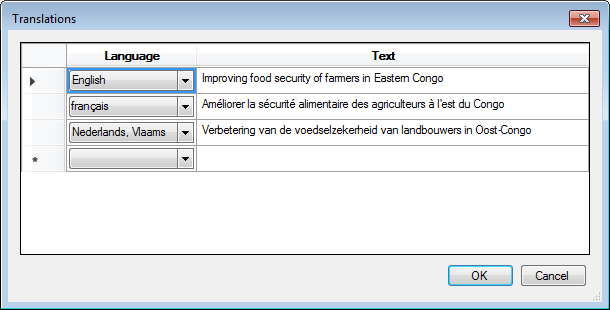
Here you can add as many translations as you want. Select the language in the first column and then the translated text in the second column.
When you return to your main window you will see the English text (if you use the English interface). If your colleague in Mali uses the French interface, he or she will see the French text.